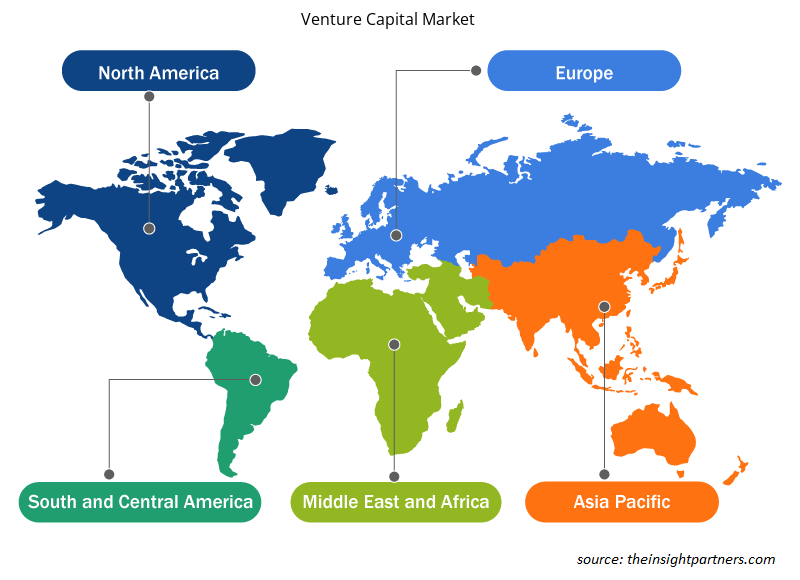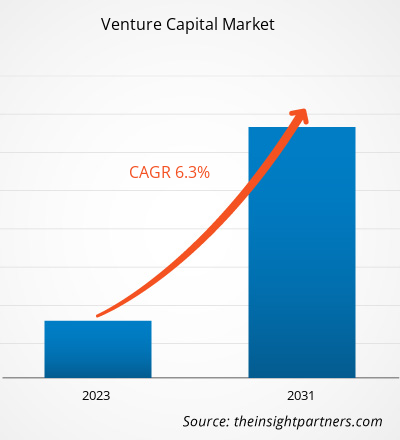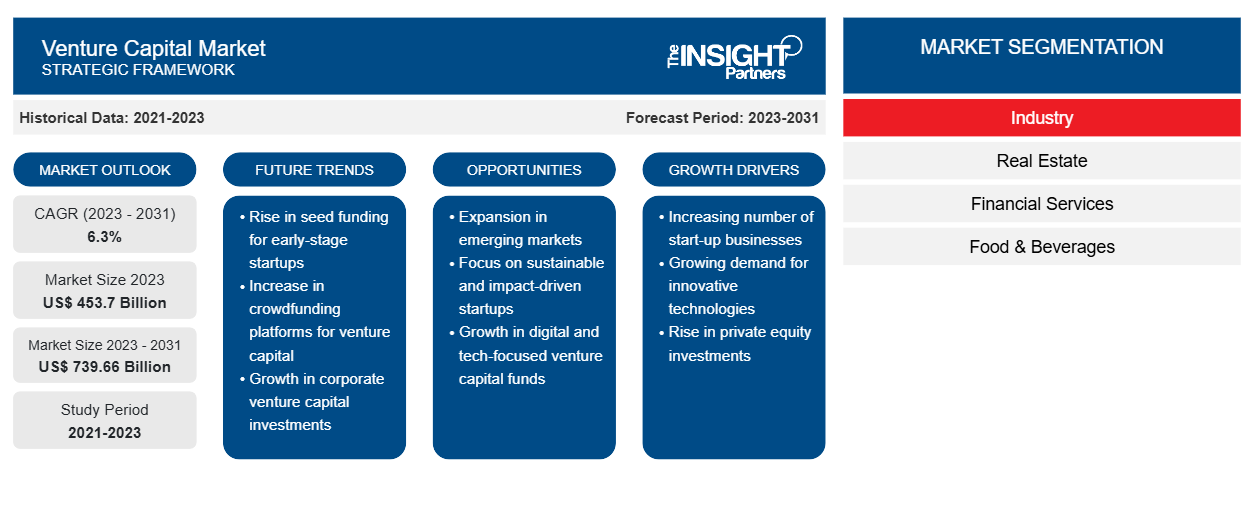ベンチャーキャピタル市場の規模は、2023年の4,537億米ドルから2031年には7,396.6億米ドルに成長すると予想されており、2023年から2031年にかけて6.3%のCAGRで拡大すると予想されています。ベンチャーキャピタル市場には、現在のベンチャーキャピタル市場の動向と予測期間中の予測可能な影響により、成長の見通しがあります。新興企業の増加、産業化、グローバル化は、市場の成長を牽引する要因の一部です。ただし、市場のボラティリティと規制上の課題が市場の成長を抑制しています。
ベンチャーキャピタル市場分析
ベンチャー キャピタル (VC) は、プライベート エクイティの一部であり、持続的な拡大が見込まれる新興企業や中小企業に資金を提供します。投資銀行、金融機関、投資家が、ベンチャー キャピタルの通常の資金源です。ベンチャー キャピタル (VC) は、投資家が大きな発展の可能性があると考える新興企業や中小企業に資金を提供します。プライベート エクイティ (PE) は通常の資金調達方法です。独立したリミテッド パートナーシップを通じて、所有権が選ばれた投資家グループに販売されます。PE は通常、株式の注入を求める既存企業に資金を提供しますが、ベンチャー キャピタルは通常、事業の発展に注力します。ベンチャー キャピタル (VC) は、特に銀行融資、資本市場、またはその他の形態の負債を利用できない新興企業にとって、重要な資金源です。シード ステージ、初期ステージ、後期ステージの資金は、ベンチャー キャピタルの 3 つのタイプです。
グローバル化は、国境を越えた商業および金融ネットワークの拡大の結果として、ここ数十年で進展し、他の経済圏の企業や労働者の相互接続がますます進んでいます。グローバル化が進むと、国際投資の機会が増え、投資に関連したプログラムが増えます。さらに、産業化によって投資の増加、より広範なコラボレーション、パートナーシップ、合弁事業も促進され、ベンチャーキャピタル市場の成長が促進されます。
要件に合わせてレポートをカスタマイズする
このレポートの一部、国レベルの分析、Excelデータパックなど、あらゆるレポートを無料でカスタマイズできます。また、スタートアップや大学向けのお得なオファーや割引もご利用いただけます。
-
このレポートの主要な市場動向を入手してください。この無料サンプルには、市場動向から見積もりや予測に至るまでのデータ分析が含まれます。
ベンチャーキャピタル業界の概要
- ベンチャー キャピタルは、負債を負うために必要なキャッシュ フローがないスタートアップ企業に資金援助を提供します。投資家は有望な企業の株式を取得し、企業は事業を開始するために必要な資金を受け取るため、この取り決めは双方にとって有利になる可能性があります。jumpstart their operations, this arrangement may be advantageous to both parties.
- VC は、アドバイザーや人材の発掘を支援するために、ネットワーキングやメンタリングのサービスを頻繁に提供しています。ベンチャー キャピタルの強力な支援があれば、企業はより多くの投資を行うことができます。 frequently offer networking and mentoring services to assist in locating advisers and talent. Having solid venture capital backing can help businesses make more investments.
- しかし、ベンチャー キャピタルの支援を受ける企業は、将来の方向性に対する創造的なコントロールを失う可能性があります。ベンチャー キャピタリスト (VC) は、会社の株式のかなりの部分を要求する可能性が高く、経営陣にプレッシャーをかける可能性もあります。
- 多くの VC は、主な目標が迅速かつ高いリターンの獲得であるため、企業に迅速な撤退を迫る場合があります。
ベンチャーキャピタル市場の推進力
ベンチャーキャピタル市場を牽引するスタートアップ企業の増加
- テクノロジーとリソースへのアクセス、起業家精神とイノベーションの文化の高まりにより、アイデアを持つ個人がそれを実行可能なビジネスに変えることが容易になっています。たとえば、SBA によると、2022 年には米国で 3,020 万の中小企業が運営され、1,000 のユニコーン企業が活動しています。
- CB Insightsによると、2024年1月現在、世界には1兆2000社を超える10億ドル規模のユニコーンスタートアップが存在します。さらに、Microsoftによると、毎年5000万社の新しいスタートアップが設立されています。つまり、平均して毎日13万7000社のスタートアップが立ち上げられていることになります。
- 革新的なアイデアを持ったスタートアップ企業を立ち上げる起業家が増えるにつれ、彼らは事業を成長させるための資金を求めています。
- ベンチャーキャピタリストは、高い収益の可能性に惹かれ、株式と引き換えにこれらのスタートアップ企業に投資します。この資本の流入によりスタートアップ企業は成長し、事業の拡大、新製品の開発、新市場への参入が可能になります。
- 成功したスタートアップ企業が投資家に利益をもたらすと、より多くの資本がベンチャーキャピタル市場に引き寄せられ、成長のサイクルが生まれます。
- 有名なスタートアップ企業の成功物語がこのサイクルをさらに加速させ、より多くの起業家が一歩踏み出して資金調達をしようと奮起し、ベンチャーキャピタル市場の成長を促進します。
ベンチャーキャピタル市場レポートのセグメンテーション分析
- ベンチャーキャピタル市場は、種類によって、地元の投資家と国際的な投資家に分類されます。
- 2023年には、地元の投資家セグメントがベンチャーキャピタル市場で大きなシェアを占めると予想されています。
- 地元の投資家は、地元の市場の動向、規制、文化的ニュアンスについて深い理解を持っていることが多く、それが有望な投資機会を特定する上で有利に働く可能性があります。
- 一方、国際的な投資家は、より広範なネットワーク、多様な視点、より大きな資本プールへのアクセスをもたらす可能性があり、これは世界規模での拡大を目指すスタートアップにとって有利となる可能性があります。
地域別ベンチャーキャピタル市場シェア分析
ベンチャー キャピタル市場の範囲は、主に北米、ヨーロッパ、アジア太平洋、中東およびアフリカ、南米の 5 つの地域に分かれています。北米は急速な成長を遂げており、ベンチャー キャピタル市場で大きなシェアを占めると予想されています。この地域の著しい経済発展、人口増加、ベンチャー キャピタルを必要とする新興企業の増加が、市場の成長に貢献しています。
ベンチャーキャピタル市場の地域別分析
予測期間を通じてベンチャー キャピタル市場に影響を与える地域的な傾向と要因は、Insight Partners のアナリストによって徹底的に説明されています。このセクションでは、北米、ヨーロッパ、アジア太平洋、中東、アフリカ、南米、中米にわたるベンチャー キャピタル市場のセグメントと地理についても説明します。

- ベンチャーキャピタル市場の地域別データを入手
ベンチャーキャピタル市場レポートの範囲
| レポート属性 | 詳細 |
|---|---|
| 2023年の市場規模 | 4,537億米ドル |
| 2031年までの市場規模 | 7,396.6億米ドル |
| 世界のCAGR(2023年~2031年) | 6.3% |
| 履歴データ | 2021-2023 |
| 予測期間 | 2023-2031 |
| 対象セグメント |
業界別
|
| 対象地域と国 |
北米
|
| 市場リーダーと主要企業プロフィール |
|
ベンチャーキャピタル市場のプレーヤー密度:ビジネスダイナミクスへの影響を理解する
ベンチャー キャピタル市場は、消費者の嗜好の変化、技術の進歩、製品の利点に対する認識の高まりなどの要因により、エンド ユーザーの需要が高まり、急速に成長しています。需要が高まるにつれて、企業は提供内容を拡大し、消費者のニーズを満たすために革新を起こし、新たなトレンドを活用し、市場の成長をさらに促進しています。
市場プレーヤー密度とは、特定の市場または業界内で活動している企業または会社の分布を指します。これは、特定の市場スペースに、その市場規模または総市場価値に対してどれだけの競合相手 (市場プレーヤー) が存在するかを示します。
ベンチャーキャピタル市場で活動している主要企業は次のとおりです。
- タイガーグローバルマネジメント
- ニューエンタープライズアソシエイツ
- セコイア・キャピタル
- DSTグローバル
- IDGキャピタル
免責事項:上記の企業は、特定の順序でランク付けされていません。

- ベンチャーキャピタル市場のトップキープレーヤーの概要を入手
「ベンチャーキャピタル市場分析」調査は、タイプ、業界、および地理に基づいて実施されました。タイプに基づいて、市場は地元の投資家と国際的な投資家に分割されています。業界に基づいて、ベンチャーキャピタル市場は、不動産、金融サービス、食品および飲料、ヘルスケア、輸送および物流、ITおよびITeS、教育、その他に分割されています。地理に基づいて、市場は北米、ヨーロッパ、アジア太平洋、中東およびアフリカ、および南米に分割されています。
ベンチャーキャピタル市場のニュースと最近の動向
ベンチャー キャピタル市場では、企業は合併や買収などの無機的および有機的な戦略を採用しています。最近の主要な市場動向をいくつか以下に示します。
- 2023年11月、IBMは、企業向けの生成型AI技術と研究の加速に重点を置いた、初期段階から急成長中のスタートアップ企業まで、さまざまなAI企業に投資する5億ドルのベンチャーファンドの立ち上げを発表しました。
[出典: IBM Corporation、企業ウェブサイト]
- 2023年9月、Amazon Catalytic Capitalは4つの新しいベンチャーキャピタルファンドに投資し、ポートフォリオの合計が8つのファンドになったと発表しました。
[出典: Amazon、企業ウェブサイト]
ベンチャーキャピタル市場レポートのカバレッジと成果物
ベンチャーキャピタル市場の予測は、主要な企業の出版物、協会データ、データベースなど、さまざまな二次および一次調査結果に基づいて推定されます。市場レポート「ベンチャーキャピタル市場の規模と予測(2021〜2031年)」では、以下の分野をカバーする市場の詳細な分析を提供しています。
- 対象範囲に含まれるすべての主要市場セグメントについて、世界、地域、国レベルでの市場規模と予測。
- 推進要因、制約、主要な機会などの市場の動向。
- 今後の主な動向。
- 詳細なPESTおよびSWOT分析
- 主要な市場動向、主要プレーヤー、規制、最近の市場動向を網羅した世界および地域の市場分析。
- 市場集中、ヒートマップ分析、主要プレーヤー、最近の動向を網羅した業界の状況と競争分析。
- 詳細な企業プロフィール。
- 過去2年間の分析、基準年、CAGRによる予測(7年間)
- PEST分析とSWOT分析
- 市場規模価値/数量 - 世界、地域、国
- 業界と競争環境
- Excel データセット
最新レポート
お客様の声
購入理由
- 情報に基づいた意思決定
- 市場動向の理解
- 競合分析
- 顧客インサイト
- 市場予測
- リスク軽減
- 戦略計画
- 投資の正当性
- 新興市場の特定
- マーケティング戦略の強化
- 業務効率の向上
- 規制動向への対応























 無料サンプルを入手 - ベンチャーキャピタル市場
無料サンプルを入手 - ベンチャーキャピタル市場